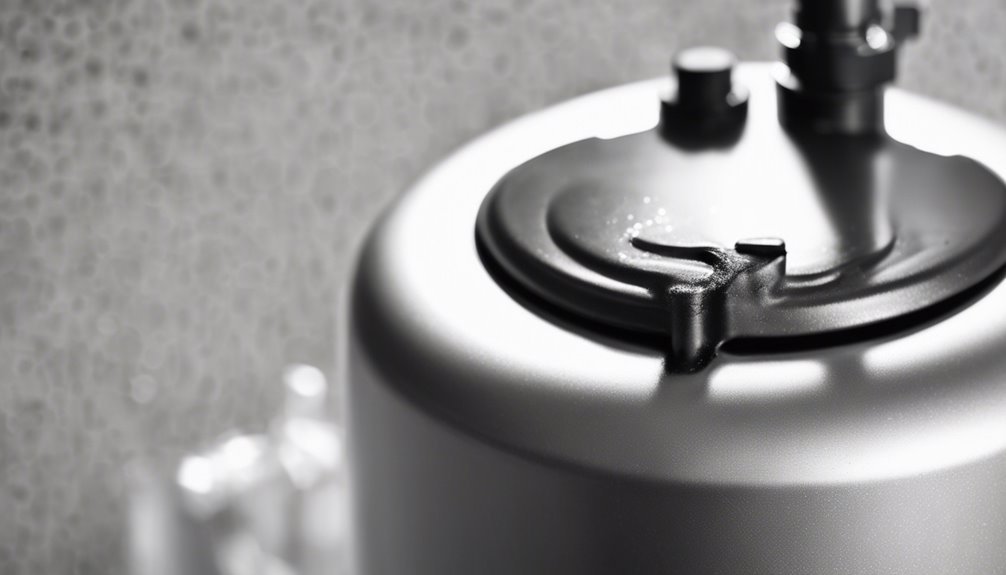What Could Blackish Silt Getting Through My Water Softner Be?
If you've noticed blackish silt coming through your water softener, it's important to understand what might be causing it. This issue could stem from several factors, including sediment buildup, high levels of iron and manganese, or even bacterial growth in your water supply. Each of these possibilities hints at underlying problems that could affect not just your water quality, but also your softener's efficiency. So, what steps can you take to identify the root cause and prevent further complications? The answers may surprise you.
Key Takeaways
- Blackish silt may indicate iron bacteria, which thrive in low-oxygen environments and lead to sediment build-up in water systems.
- High levels of iron and manganese in your water source can contribute to blackish silt and clogging issues in the water softener.
- Inadequate filtration and poor maintenance can exacerbate sediment accumulation, allowing contaminants to pass through the water softener.
- Biofilm formation within the water system can release particles, contributing to the blackish silt observed in the softened water.
- Regular water testing and maintenance are crucial to identify and address the causes of blackish silt in your water supply.
Understanding Water Softener Functionality
To grasp how water softeners work, it's essential to understand the underlying principles of ion exchange. This process involves the replacement of calcium and magnesium ions, which cause water hardness, with sodium or potassium ions.
You'll encounter various water softener types, including salt-based, salt-free, and dual-tank systems, each designed to tackle hardness differently.
A salt-based softener uses a resin bed, where hard water passes through and exchanges its calcium and magnesium ions for sodium ions. It periodically regenerates by flushing the resin with a brine solution, an important step in softener maintenance. Neglecting this maintenance can lead to decreased efficiency, resulting in hard water bypassing the system.
Salt-free softeners, on the other hand, utilize a different mechanism, often employing a template-assisted crystallization process to prevent scale buildup without ion exchange. While they require less frequent maintenance, they may not be as effective in regions with severe hardness.
Regular inspection and maintenance of your chosen water softener type guarantee peak performance, extending the life of the unit and improving water quality.
Understanding these functionalities empowers you to make informed decisions regarding your home's water treatment needs.
Common Causes of Blackish Silt
When you encounter blackish silt in your water softener, it's often due to the presence of iron bacteria, which thrive in oxygen-poor environments.
These microorganisms can lead to sediment build-up, contributing to the discoloration and potential clogging of your system.
Understanding these common causes is essential for effective maintenance and ensuring peak water quality.
Iron Bacteria Presence
Iron bacteria are a common culprit behind the appearance of blackish silt in water softeners. These microorganisms thrive in environments where iron and manganese are present, leading to water contamination.
When you notice blackish silt, it's important to assess the quality of your water source, as iron bacteria often proliferate in wells or groundwater containing high levels of dissolved iron.
The presence of iron bacteria can create a slimy biofilm, which may break apart and contribute to the silt you see. This biofilm can also clog your water softener, impacting its efficiency and leading to further water quality issues.
You might find that the blackish silt has a distinct odor, often described as earthy or musty, which can be another indicator of iron bacteria.
To address this issue, consider conducting water testing to confirm the presence of iron bacteria. If detected, implementing disinfection methods, such as chlorination or shock treatment, can help eliminate these microorganisms.
Regular maintenance of your water softener, including cleaning and sanitizing, is essential to prevent the recurrence of iron bacteria and the blackish silt they cause.
Sediment Build-Up
Sediment build-up in your water softener can often lead to the formation of blackish silt, resulting from various factors that affect water quality.
Different sediment types, such as clay, silt, and organic matter, can accumulate in your system, especially if the source water isn't sufficiently filtered. This accumulation can occur when filtration methods are inadequate to remove fine particles effectively.
When sediment settles in the resin bed or the brine tank, it can mix with minerals and other contaminants, creating the blackish silt you observe.
Furthermore, if your water supply contains high levels of dissolved iron or manganese, they can oxidize and contribute to the discoloration. Inadequate maintenance and infrequent cleaning of your water softener can exacerbate these issues, allowing sediment to build up over time.
To mitigate sediment build-up, regularly inspect and maintain your filtration system.
Employing advanced filtration methods, such as multi-stage filters or sediment filters, can greatly reduce the amount of sediment entering your water softener.
Impact of Manganese and Iron
Manganese and iron in your water supply can greatly influence its quality, leading to both aesthetic and functional issues.
When manganese is present, it can create blackish silt that not only affects the appearance of your water but can also stain fixtures and laundry.
Moreover, iron buildup can cause clogging in your water softener, reducing its efficiency and increasing maintenance needs.
Manganese Presence Effects
Experiencing issues with blackish silt in your water softener often signals the presence of manganese and iron, two elements that can greatly impact water quality.
Manganese, when present in your water supply, can lead to aesthetic problems, as it imparts a dark color and unpleasant taste. Furthermore, manganese oxidation occurs when water is exposed to air, transforming soluble manganese into an insoluble form that can contribute to the silt you're observing.
Manganese removal is essential to maintaining both the efficiency of your water softener and the overall quality of your water. If left untreated, manganese can accumulate within your system, leading to clogs and decreased performance.
It's important to monitor manganese levels in your water supply, as high concentrations may necessitate specialized treatment methods, such as oxidation filtration or chemical treatments.
Incorporating a manganese removal process can considerably enhance your water quality. This can involve utilizing specific media designed to filter out manganese or employing oxidizing agents that facilitate the conversion of manganese into a removable form.
Staying proactive about manganese presence can prevent complications and guarantee that your water remains clean and safe for consumption.
Iron Buildup Issues
The presence of iron in your water supply often compounds the problems associated with manganese buildup. When both elements coexist, they can create a stubborn sludge that's difficult to manage. Addressing iron removal becomes vital to maintaining your water softener's efficiency.
To better understand the impact of iron and manganese, consider the following table:
| Factor | Impact on Water Quality |
|---|---|
| Iron Concentration | Causes staining and discoloration |
| Manganese Concentration | Contributes to blackish silt |
| Combined Presence | Increases sludge formation |
| Water Testing Methods | Critical for diagnosing issues |
| Iron Removal Options | Filtration and chemical treatments |
Regular water testing is crucial in identifying the levels of iron and manganese in your supply. High concentrations can lead to clogging in your softener, reducing its effectiveness. Implementing effective iron removal techniques not only enhances your water quality but also prolongs the lifespan of your equipment. By addressing these buildup issues proactively, you can guarantee your water remains clear and free of unwanted silt.
Water Quality Concerns
Many homeowners may not realize that elevated levels of manganese and iron can markedly impact water quality. These elements, while naturally occurring, can lead to a range of issues, such as staining fixtures, altering taste, and potentially affecting health.
If you've noticed blackish silt in your water softener, it's crucial to conduct water testing to determine the concentration of these metals.
High manganese levels can cause neurological concerns, particularly in children, while excessive iron can promote bacterial growth, leading to clogged pipes and inefficient filtration systems.
When evaluating your water quality, focus on both total dissolved solids and specific contaminants. Regular testing allows you to identify problematic levels before they become significant issues.
If your tests reveal elevated manganese or iron levels, consider upgrading your filtration systems. Options like reverse osmosis or specialized manganese and iron filters can effectively reduce these impurities, ensuring cleaner, safer water for your household.
Don't overlook the importance of routine maintenance and testing, as these practices help keep your water supply free from harmful elements, preserving both the quality of your water and the longevity of your plumbing.
Bacterial Growth in Water Systems
When water systems aren't properly maintained, bacterial growth can thrive, leading to notable issues in water quality. Bacterial contamination often arises from stagnant water, inadequate filtration, or a failure to disinfect the system effectively.
When these bacteria proliferate, they can produce biofilms, which not only clog filters but also release toxins that compromise the safety of your water supply.
If you notice blackish silt in your water softener, it could indicate a breeding ground for bacteria. Biofilms can form on the surfaces of pipes and filtration systems, contributing to the blackish material you're observing. This situation can lead to reduced efficiency in your water filtration process, making it vital to address the underlying causes promptly.
To mitigate bacterial growth, regular maintenance is key. You should routinely clean and disinfect your water systems and replace any worn-out filtration components.
Monitoring water quality through testing can also help you identify potential bacterial issues before they become major problems. By staying proactive in your maintenance, you can meaningfully reduce the risk of bacterial contamination and guarantee the water you use remains safe and clean.
Age and Maintenance of Water Softener
Bacterial growth isn't just a concern; it can also signal issues related to the age and maintenance of your water softener. Understanding the water softener lifespan is essential for peak performance. Generally, a well-maintained water softener lasts between 10 to 15 years. However, neglecting regular upkeep can greatly shorten this lifespan and lead to problems like blackish silt.
To guarantee longevity, follow some important maintenance tips. First, check the salt levels monthly and refill as needed to avoid salt bridges. Second, clean the brine tank every six months to remove any buildup that can promote bacterial growth.
Furthermore, inspect the system for leaks or corrosion, which can compromise efficiency. Consider scheduling a professional inspection every few years to catch any underlying issues before they escalate.
If you notice a decline in performance or unexpected materials in your water, it might point to age-related wear or insufficient maintenance. By staying proactive, you can extend your water softener's lifespan, reduce the risk of bacterial contamination, and maintain the quality of your water supply.
Sediment From Plumbing Issues
Sediment buildup in your water softener can often stem from plumbing issues, which may compromise the system's efficiency and water quality. When pipes corrode or deteriorate, they can release particles into your water supply. These particles often manifest as blackish silt, clogging your water softener and impairing its filtration process.
Regular plumbing maintenance is essential to preventing such sediment issues. Without routine inspections and timely repairs, you risk allowing rust, mineral deposits, and other contaminants to enter your water softener. Over time, these substances accumulate, leading to decreased performance and potential damage to your unit.
Moreover, inadequate water filtration can exacerbate these problems. If your plumbing system isn't equipped with a reliable filtration mechanism, larger debris can flow into your softener, compounding sediment issues.
Installing a pre-filter can help capture these particles before they reach your softener, ensuring cleaner water and extending the lifespan of your equipment.
Identifying Contaminants in Water
Many homeowners might notice unusual changes in their water quality, prompting the need to identify potential contaminants present.
Blackish silt in your water could indicate specific issues that require investigation. To effectively identify these contaminants, consider the following steps:
- Conduct Water Testing: Use a reliable home testing kit or seek professional services. This will help you pinpoint specific contaminants like heavy metals, bacteria, or sediment.
- Examine Filtration Methods: Assess your current filtration methods. If your system isn't working efficiently, it may not remove all impurities, leading to discoloration in your water.
- Check for Environmental Factors: Look into nearby construction or industrial activities. These can introduce pollutants into your water supply that may not be immediately apparent.
- Inspect Plumbing Infrastructure: Corroded pipes or outdated fixtures can leach contaminants into your water. Regular inspections can help identify these issues before they escalate.
Solutions and Preventative Measures
To effectively address the issue of blackish silt in your water softener, you should implement a combination of solutions and preventative measures tailored to your specific situation. Start with regular water testing to identify the presence of contaminants that could contribute to the silt. Knowing what's in your water helps you take appropriate action.
Next, guarantee timely filter replacement based on the manufacturer's recommendations or when testing indicates a need. Old or clogged filters can exacerbate silt issues.
Here's a quick reference table to help you:
| Solution | Frequency | Action Required |
|---|---|---|
| Water Testing | Every 6 months | Test for contaminants |
| Filter Replacement | Every 3-6 months | Replace with new filters |
| System Maintenance | Annually | Inspect and clean system |
Frequently Asked Questions
Can Blackish Silt Affect the Taste of My Water?
Yes, blackish silt can cause taste issues in your water. This silt may indicate poor water quality, potentially introducing contaminants that alter flavor. Regular testing and maintenance of your water system can help guarantee better taste and quality.
How Can I Test My Water for Contaminants?
You can test your water for contaminants by using a home testing kit, which analyzes for heavy metals, bacteria, and other contamination sources. Consider a case where lead leached from old pipes affected local water supplies.
Is Blackish Silt Harmful to My Health?
Blackish silt can pose health risks, often indicating contamination sources like sediment or decaying organic matter. You should analyze the silt further, as understanding its composition helps determine potential health implications for you and your household.
What Should I Do if My Water Softener Leaks?
Think of your water softener as a ship; leaks can sink it. For effective water softener maintenance, regularly inspect connections and seals, and implement leak prevention strategies to guarantee smooth sailing for your system.
How Often Should I Replace My Water Softener Resin?
You should replace your water softener resin every 5 to 10 years, depending on usage and water quality. Regular resin maintenance helps guarantee peak performance, preventing issues related to hardness and prolonging your system's lifespan.
Conclusion
To summarize, blackish silt in your water softener isn't just a nuisance; it's a glaring warning sign of potential chaos in your water system. If left unchecked, it could lead to a veritable swamp of bacterial growth and sediment buildup that transforms your water quality into a murky mystery. By staying vigilant with regular testing and maintenance, you can prevent your water from turning into a science experiment gone wrong, ensuring it remains clean and safe.







